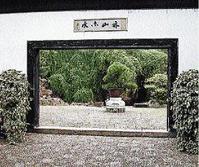
Entrance to the Garden of the Master of Fishing Nets.- contributed.Suzhou is an ancient Chinese city, located 100 kilometres east of Shanghai. It is a famous cultural city with a history of more than 2,500 years.
Suzhou is known in particular for its classical gardens. Four of them are on UNESCO's World Cultural Heritage list:
1. Humble Administrator's Garden
2. The Garden to Linger In
3. Garden of the Master of Fishing Nets
4. Huanxiu (Circular Grace) Mountain Villa
Of all the beautiful Suzhou gardens, the Garden of the Master of Fishing Nets is unique for its small size and especially exquisite buildings, elegant landscaping, and compact structures.
As appropriate to the old Suzhou style, entrance into the garden is gained by way of the back door or a side hallway of the former residence!
Various buildings are found around a pond at the centre of the garden, with poetic names such as the Pavilion for the Advent of the Moon and Wind, the Duck-shooting Corridor, and Ribbon-Washing Pavilion at the Waterfront, which, though small, blend perfectly with the water surface.
Taller buildings are tucked way behind trees, rocks and pavilions to render depth to the entire setting. This resourceful architectural layout is a salient feature of the Garden of the Master of Fishing Nets.
The feudal Chinese economy and culture reached a period of prosperity, and the art of garden landscaping achieved full maturity. A contingent of garden artists and builders emerged, propelling garden construction to a climax, and the number of private gardens and courtyards topped 270 in Suzhou. No other Chinese city had as many private gardens.
The gardens existing to this day were mostly owned by individuals obsessed with a tranquil and nature-friendly environment.
In traditional Chinese gardens, a limited space is ingeniously divided into sceneries that are evocative of the techniques of traditional Chinese landscape painting. A garden is thus called a three-dimensional Chinese landscape painting!
Rita Elliott

